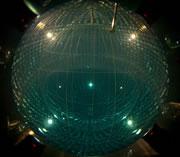 A giant sphere of purified water deep underground: handy for spotting neutrinos.Borexino calibration
A giant sphere of purified water deep underground: handy for spotting neutrinos.Borexino calibrationLow-energy neutrinos from the Sun have been spotted by researchers for the first time. Detecting these solar particles confirms theories about how nuclear fusion occurs within the Sun, and how neutrinos oscillate between different types.
Neutrinos are fundamental particles with a very small mass and no electrical charge. They are produced in large numbers in solar thermonuclear reactions but tend not to interact with anything they hit, allowing them to pass largely unhindered from the Sun straight through the Earth.
Previous experiments at labs have detected neutrinos and demonstrated that they oscillate between three types (or 'flavours'): electron, muon and tau neutrinos. That cracked many of the bigger questions about neutrinos. But the earlier experiments were not able to measure solar neutrinos with energy levels of less than 5 mega electronvolts (MeV), as natural radioactivity in the surroundings can obscure results.
The Borexino experiment, in the Gran Sasso National Laboratory near L'Aquila in Italy, was designed to get around this problem and detect particles with energies of less than 1 MeV.
The detector is a 18-metre-diameter dome, the interior of which is shielded by 2,400 tonnes of purified water. This blocks radioactive contamination from natural elements in the Earth and air. At the inner core, a liquid emits light when hit by a subatomic charged particle such as a neutrino. All the materials used in the experiment contain extremely low amounts of naturally radioactive elements.
The project officially started many years ago but has experienced delays (see Pollution fears put work at neutrino laboratory on hold). After the ethe experiment started up in May 2007, researchers detected nearly 50 neutrinos per day, as solar models had predicted.
"I am impressed by the way they were able to control radioactivity," says Arthur McDonald, from Queen's University in Kingston, Ontario, Canada, who is also director of the Sudbury Neutrino Observation (SNO) in Ontario, Canada.
The team, composed of nearly 100 researchers from Italy, the United States, Russia, Germany, France and Poland, say the neutrinos match what they would expect to see from the radioactive decay of beryllium-7 in the Sun.
ADVERTISEMENT
"This is a nice demonstration and I also expect more precise measurements," says Stuart Freedman, a physicist at the University of California at Berkeley and a leader of the US-Japanese collaboration which built and operates the KamLAND facility in Kamioka, Japan, which also aims to analyse low-energy solar neutrinos.
In future, the Borexino experiment will aim to detect neutrinos coming from radiation in the Earth's interior.
Visit our neutrinosspotted.html">newsblog to read and post comments about this story.
-
References
- et al. Phys. Lett. (submitted), http://arxiv.org/abs/0708.2251
